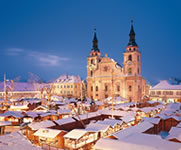
The Silver Mines Route also gives visitors the chance to discover a number of industrial heritage sites. A trip to the visitor mines and a look at the working ore hammers offer a glimpse of working life in previous generations. Where craftsmanship and technology thrive, artistic endeavours are also sure to flourish. This is evident everywhere, from the treasuries of the Wettin dynasty, who ruled the area for 800 years, to the architectural monuments in the old trade and guild centres. The proceeds from silver mining also made a substantial contribution to the fame and fortune of the Saxon royal family in their ancestral town of Dresden. Great inventors, scientists and intellectuals of the age also lived and worked here: people famous far beyond the borders of Saxony, such as Georgius Agricola, the father of mineralogy, or Adam Riese, the influential arithmetician. If you travel on the Silver Mines Route be sure not to miss another "silver marvel", the famous Silbermann organs with their beautiful sound, built by Gottfried Silbermann, the Saxon master organ builder.

Along the whole length of the Silver Mines Route, visitors will encounter a warm sense of hospitality. The biggest open-air museum in the world, it includes sections where those who enjoy horse riding, cycling or walking can go and explore it in their own favourite way. A museum tour is another great way for visitors to experience the region's wealth of traditions and customs. In summer, the countryside around the "Silver Route" is a riot of pretty colours and in winter an enchanting fairytale "world of Christmas" with an air of romance. "Glück auf!" (Good luck!), the traditional miner's greeting, is the local way of welcoming people to this most remarkable region.
 Skip to content
Skip to navigation
Skip to subnavigation
Skip to search
Skip to content
Skip to navigation
Skip to subnavigation
Skip to search







